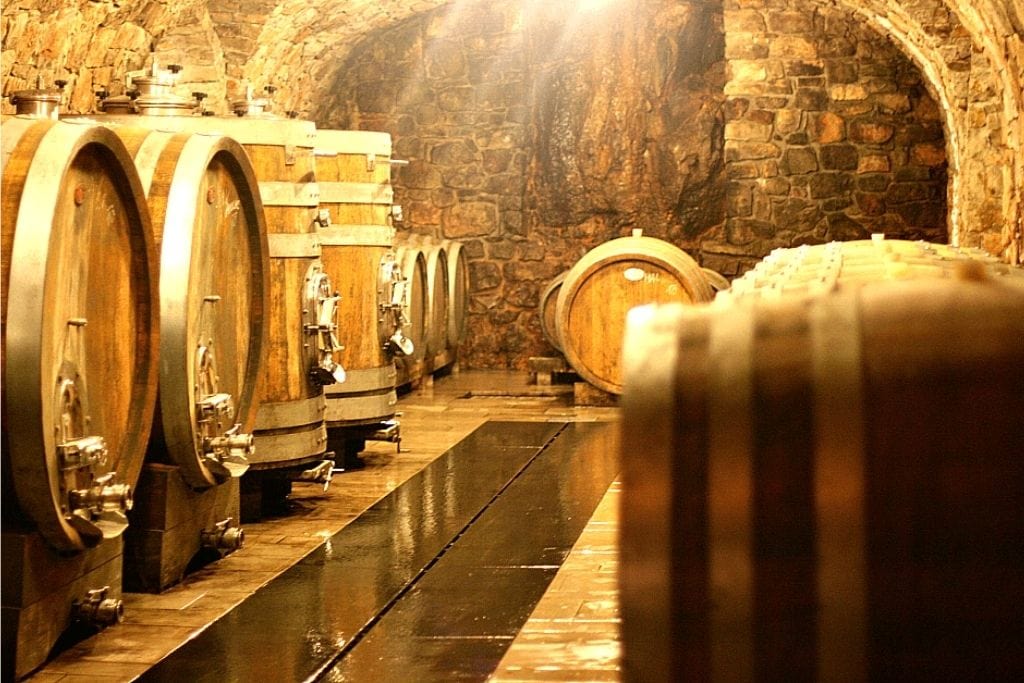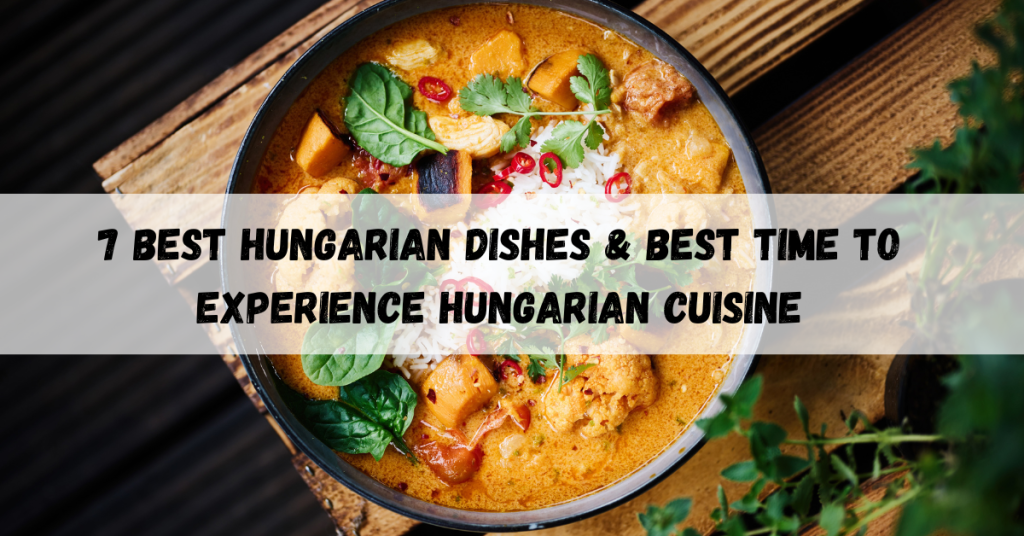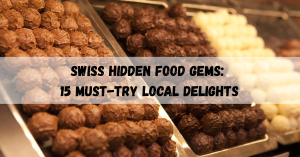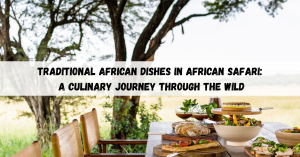Traditional Hungarian Dishes

Hungary’s cuisine is hearty, flavorful, and deeply rooted in tradition. Dishes like goulash, pörkölt (Hungarian stew), and halászlé (fisherman’s soup) showcase the bold use of paprika, garlic, and fresh local ingredients. These meals are often enjoyed in csárdas (traditional Hungarian taverns), offering a true taste of Hungarian comfort food.
-
Goulash, The National Dish
- One of Hungary’s most famous dishes, goulash is a hearty beef stew made with paprika, potatoes, and vegetables.
- It is slow cooked over an open fire, preserving its rich, smoky flavor.
- Best enjoyed in autumn and winter, when its warmth provides the perfect comfort meal.
-
Halászlé (Fisherman’s Soup)
- A spicy Hungarian fish soup, made with freshwater fish, paprika, and onions.
- It originates from riverside towns along the Danube and Tisza and is a staple of Hungarian cuisine.
- Best experienced during summer fishing festivals, when the fish are freshest.
-
Pörkölt (Hungarian Stew)
- Similar to goulash but thicker and richer, made with beef, pork, or chicken.
- Served with dumplings (nokedli), enhancing the dish’s hearty and comforting appeal.
- A countryside specialty, often enjoyed in Hungarian village restaurants.
-
Lángos, The Favorite Street Food
- A deep-fried flatbread, typically topped with sour cream, cheese, and garlic.
- A popular Hungarian street food, found in markets, beaches, and festivals.
- Best eaten hot and crispy, making it an ideal summer snack.
-
Hortobágyi Palacsinta (Stuffed Pancakes)
- A savory Hungarian pancake, filled with minced meat and topped with a paprika-infused sauce.
- Baked until golden and crispy, creating a rich and flavorful dish.
- Commonly found in traditional Hungarian restaurants, perfect for those seeking authentic flavors.
Hungarian Desserts & Sweets

Hungarian desserts are as rich in flavor as their main dishes. Chimney cakes (kürtőskalács) are a street food favorite, while dobos torte, a caramel-topped sponge cake, is a must-try in local bakeries. Classic sweets like bejgli (walnut or poppy seed roll) are popular during the holiday season, making them a delicious part of Hungary’s culinary heritage.
-
Kürtőskalács (Chimney Cake)
- One of Hungary’s most famous desserts, known for its crispy caramelized sugar coating.
- Baked over a rotating spit, giving it a golden brown, crunchy exterior and a soft, fluffy interior.
- Found at Christmas markets, street vendors, and pastry shops year-round, making it a must-try sweet treat.
-
Dobos Torte, The Famous Hungarian Cake
- A legendary Hungarian dessert, created by confectioner József Dobos in the 19th century.
- Features multiple layers of sponge cake, filled with rich chocolate buttercream and topped with a caramelized sugar glaze for an irresistible crunch.
- Popular in traditional pastry shops and cafes throughout Hungary, especially in Budapest.
Hidden Gem Food Experiences

Beyond famous dishes, Hungary offers unique food experiences in lesser-known spots. Visit Eger’s wine cellars for a glass of Egri Bikavér (Bull’s Blood wine) or explore the Tihany Peninsula for its lavender-infused honey. In the Great Hungarian Plain, try traditional shepherd meals, while small towns like Kőszeg and Hollókő offer authentic home-cooked Hungarian dishes rarely found in big cities.
Famous Restaurants in Hungary

| Restaurant | Location | Specialty | Why Visit? |
|---|---|---|---|
| Gundel Restaurant | Budapest | Traditional Hungarian fine dining | One of Hungary’s most historic restaurants, known for Gundel Pancakes & Goulash |
| Onyx | Budapest | Michelin-starred modern Hungarian cuisine | Offers elevated Hungarian dishes with a gourmet twist |
| Halászbástya Restaurant | Budapest | Hungarian & International fusion | Stunning views of the Danube and Buda Castle |
| Macok Bistro | Eger | Wine & traditional Hungarian dishes | Located near Eger Castle, serves local specialties with Eger’s famous wines |
| Babel Budapest | Budapest | Fine dining with seasonal Hungarian ingredients | Renowned for its innovative, farm-to-table approach to Hungarian cuisine |
Best Time to Experience Hungarian Cuisine
Hungary’s food culture thrives throughout the year, but some seasons are better for certain experiences
- Spring & Summer (April–August): Best for street food, lakeside dining, and wine festivals.
- Autumn (September–November): Ideal for harvest feasts, traditional stews, and wine-tasting tours.
- Winter (December–February): Perfect for Christmas markets, chimney cakes, and hot soups.
Hungary is a food lover’s paradise, offering everything from traditional Hungarian cuisine to hidden gastronomic treasures. Whether you’re indulging in goulash, chimney cakes, or Hungarian wines, or exploring off-the-beaten-path towns, wine cellars, and historic markets, Hungary’s rich culinary scene and cultural heritage promise an unforgettable experience. From the vibrant Christmas markets in Budapest to the wine regions of Tokaj and Eger, every season brings a unique food and travel adventure.
FAQs on Best Hungarian Dishes
1. What is the best time to visit Hungary for food lovers?
The best time is September–November for the harvest season and wine festivals. However, winter brings magical Christmas markets in Hungary, offering unique culinary delights.
2. Where can I find the best traditional Hungarian food?
Visit rural villages, Budapest’s Central Market Hall, and local food festivals to experience authentic Hungarian dishes made with fresh, local ingredients.
3. What is the most unique Hungarian dish?
Halászlé (Fisherman’s Soup) stands out for its rich, spicy paprika broth and freshwater fish, commonly found along the Danube and Tisza rivers.
4. Are there food festivals in Hungary?
Yes! Hungary hosts amazing food festivals like the Budapest Wine Festival, Mangalica Festival (dedicated to Hungarian pig breeds), and the Chimney Cake Festival, celebrating one of the country’s most beloved desserts.
5. What hidden gems should I visit beyond Budapest?
Explore Hollókő for its folk culture and traditional cuisine, Szentendre for its art scene and historic cafés, and Aggtelek National Park for breathtaking cave dining experiences and authentic countryside meals.




